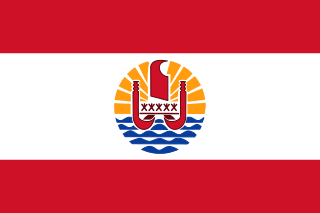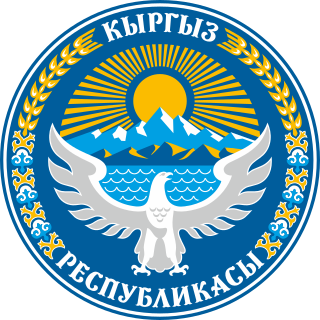
The coat of arms of the Philippines features the eight-rayed sun of the Philippines with each ray representing the eight provinces which were placed under martial law by Governor-General Ramón Blanco Sr. during the Philippine Revolution, and the three five-pointed stars representing the three major island groups of Luzon, the Visayas, and Mindanao.

The national emblem of Cape Verde contains a circle within which is written the name of the nation in Portuguese. Within the circle are a torch and triangle, symbols of freedom and national unity. At the top of the shield is a plumbob, a symbol of righteousness; three chain links are at the bottom. This emblem replaces the earlier variant with the seashell that had been in use since independence. The current emblem was adopted in 1992.

The flag of French Polynesia is the civil and state flag of the French overseas country French Polynesia. It was adopted in 1984. According to the articles of adoption, the flag of French Polynesia must be displayed with the French tricolor, and may be displayed with the flags of the component archipelagos. The French Polynesian flag must be displayed to the left of the French flag, and the flag of the archipelago must be displayed to its right.
This armorial of sovereign states shows the coat of arms, national emblem, or seal for every sovereign state. Although some countries do not have an official national emblem, unofficial emblems which are de facto used as national emblems are also shown below.

Every sultan of the Ottoman Empire had his own monogram, called the tughra, which served as a royal symbol. A coat of arms in the European heraldic sense was created in the late 19th century. Hampton Court requested from the Ottoman Empire a coat of arms to be included in their collection. As the coat of arms had not been previously used in the Ottoman Empire, it was designed following this request, and the final design was adopted by Sultan Abdul Hamid II on 17 April 1882.

The Blue Sky with a White Sun is the national emblem of the Republic of China (Taiwan).

The National emblem of Kyrgyzstan was adopted in 2016. The emblem has a circular form which mostly bears the color blue. Light blue is known as the Kyrgyz color of courage and generosity. To the left and right of the coat of arms, wheat and cotton are displayed. In the upper part, the name of the country appears in Kyrgyz "Кыргыз Республикасы". It was designed by A. Abdraev and S. Dubanaev.

A cross pattée, cross patty, or cross paty, also known as a cross formy or cross formée, is a type of Christian cross with arms that are narrow at the centre, and often flared in a curve or straight line shape, to be broader at the perimeter. The form appears very early in medieval art, for example in a metalwork treasure binding given to Monza Cathedral by Queen Theodelinda, and the 8th-century lower cover of the Lindau Gospels in the Morgan Library. An early English example from the start of the age of heraldry proper is found in the arms of Baron Berkeley.

The state emblem of Uzbekistan was formally adopted on July 2, 1992 by the newly establish Republic of Uzbekistan. It bears many similarities to the emblem of the previous Uzbek SSR, which Republic of Uzbekistan succeeded. Like other post-Soviet republics whose symbols do not predate the October Revolution, the current emblem retains some components of the Soviet one. Prior to 1992, Uzbekistan had an emblem similar to all other Soviet Republics, with standard communist emblems and insignia.

The first coat of arms of Montreal was designed by Jacques Viger, the first mayor of Montreal, and adopted in 1833 by the city councillors. Modifications were made some one hundred five years later and adopted on 21 March 1938, and again on 13 September 2017, resulting in the version currently in use. The coat of arms was the only city emblem representing Montreal until 1981, when a stylized logo was developed for common daily use, reserving the coat of arms for ceremonial occasions.

The coat of arms of Somalia was adopted on October 10, 1956 and features a golden framed shield of the Somali flag supported by two Leopards standing on spears. The Leopard is a common animal seen in Somalia. Leopards are a common motif in Somali culture.

The national emblem of Iran since the Iranian Revolution features four curves and a sword, surmounted by a shadda. The emblem was designed by Hamid Nadimi, and was officially approved by Ayatollah Ruhollah Khomeini, the first supreme leader of Iran, on 9 May 1980.

The State Emblem of the Tajik Soviet Socialist Republic was adopted on March 1, 1937 by the government of the Tajik Soviet Socialist Republic. The emblem is based on the State Emblem of the Soviet Union. It shows symbols of agriculture. The red star is prominently featured with a small hammer and sickle within it. The rising sun stands for the future of the Tajik nation, and the star as well as the hammer and sickle for the victory of communism and the "world-wide socialist community of states". The emblem was replaced with the new emblem in 1992, which uses a similar design to the Soviet one. It was, however, was replacing the red banner with the current national flag, the big red star was replaced by the mountains, represents Pamir, the Samanid dynasty crown, and added the Quran book at below. It represents Islam as the official religion.

Guadeloupe, a région and overseas département of France in the Caribbean, does not have an official coat of arms, however an unofficial coat of arms and a government logo are sometimes used in a similar capacity.

Martinique, a région and overseas département of France in the Caribbean, has historically used a coat of arms with four white fer-de-lance vipers since 4 August 1766. However, the coat of arms has become controversial due to its association with the territory's history of slavery, and its use has been discouraged by local Martinicans. The Regional Assembly has adopted a distinctive logo to represent the Territorial Collectivity of Martinique.

Various logos and emblems have been used to represent the Collectivity of Saint Martin. The most recent coat of arms used by the collectivity were adopted in 2010.
This gallery shows the coat of arms of each of the Dependent territories in the list of countries.
The national symbols of North Macedonia, as stated in the constitution, are the coat of arms, the flag and the anthem. After the independence of North Macedonia from Yugoslavia, the country made some changes in the national symbols. The flag was changed two times and today's flag includes an eight-ray sun on a red background, while the coat of arms from the Socialist Republic of Macedonia was retained, except the red star which was removed.
Communist symbolism represents a variety of themes, including revolution, the proletariat, the peasantry, agriculture, or international solidarity. The red flag, the hammer and sickle and the red star or variations thereof are some of the symbols adopted by communist movements, governments, and parties worldwide.

















